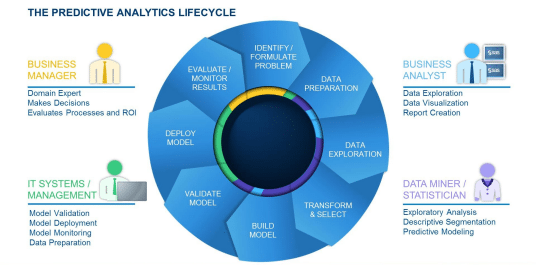Microsoft Azure Data Engineering Training Cou ...
- 16k Enrolled Learners
- Weekend/Weekday
- Live Class
The purpose of analytics is not just to understand why you lost an employee but how you can prevent from losing one. Insight is the soul of Predictive Analytics. How organizations create and use data is changing the process of life, work or leisure.
This webinar blog focuses on how smarter organizations are adopting Predictive Analytics and rightly so! It also dwells on the following topics:
BI is basically what is happening to your business. It is used for visibility. Data Warehousing and visualization dashboards are enablers of BI. While BA is why it is happening; what is likely to happen in future. It is used for investigation, prediction and prescription. Data Analytics and Data Science are enablers of BA.
There are three types of analytics:
This extends beyond measuring and describing the past to predicting what is likely to happen and optimizing what should happen.
Predictive Analytics is the analysis of data by using statistical algorithms and machine-learning techniques to identify the likelihood of future outcomes based on historical data.
Let’s look at the image below to understand the lifecycle of Predictive Analytics:

Predictive Analysis helps analyze past business performance in order to gain insight that can drive business decisions and actions.
According to Forbes, the top objective for between two-thirds and three-quarters of executives is to develop the ability to model and predict behaviours to the point where individual decisions can be made in real time, based on the analysis at hand.
Predictive Analytics is no longer the sole domain of data scientists. As predictive analytics software is getting easier to use, it’s no surprise the technology is being adopted across industries. Some of the major domains using Predictive Analytics are banking, e-commerce, HR, retail, transport, healthcare, IT industry among many others.
Let’s find out how Predictive Analytics can prevent employee attrition prevention:
Churn or attrition is when your customers reduce their usage or completely stop using your products or services. They leave your brand and might shop with your competitor. Churn prediction is a common application where the number of churners is typically small compared to the number of customers that stay.
Let’s take a look at the graphics below to understand how analytics can help an HR:
From predicting attrition among high performers to predicting how compensation values will pan out, an HR can benefit enormously from Predictive Analysis :

The image below explains the different stages involved in analytics:

Apart from the previous factors, an HR should pay attention to:

1. Keeping a metric live even when it has no clear business reason.
2. Relying on just a few metrics to evaluate employee performance. Smart employees can play with the system.
3. Insisting on 100% accurate data before an analysis is accepted — which amounts to never making a decision.
4. Assessing employees only on simple measures such as grades and test scores, which often fail to accurately predict success.
5. Using analytics to hire lower-level people but not when assessing senior management.
6. Analyzing HR efficiency metrics only, while failing to address the impact of talent management on business performance.
Predictive Analysis can precisely identify the value of a 0.1% increase in employee engagement among employees at a particular store. For example, at Best Buy the value is more than $100,000 in the store’s annual operating income.
Many companies favor job candidates with stellar academic records from prestigious schools — but AT&T and Google have established through quantitative analysis that a demonstrated ability to take initiative is a far better predictor of high performance on the job.
Sprint has identified the factors that best foretell which employees will leave after a relatively short time. In three weeks, Oracle was able to predict which top performers were predicted to leave the organization and why. This information is now driving global policy changes in retaining key performers and has provided the approved business case to expand the scope to predicting high performer flight.
Problem statement:
An Indian MNC has a linear growth model. It wants to identify relationship between % revenue growth and % headcount growth. They have revenue and headcount details for the past 10 years.
Solution approach:
Problem statement:
An HR manager identifies 20 variables such as educational qualification, college, age, gender, nationality etc. that predicts the hiring effectiveness. He wants to identify mutually exclusive variables which affect hiring effectiveness.
Solution approach:
Got a question for us? Mention them in the comment section and we will get back to you.
Related Posts:
 Thank you for registering Join Edureka Meetup community for 100+ Free Webinars each month JOIN MEETUP GROUP
Thank you for registering Join Edureka Meetup community for 100+ Free Webinars each month JOIN MEETUP GROUPedureka.co